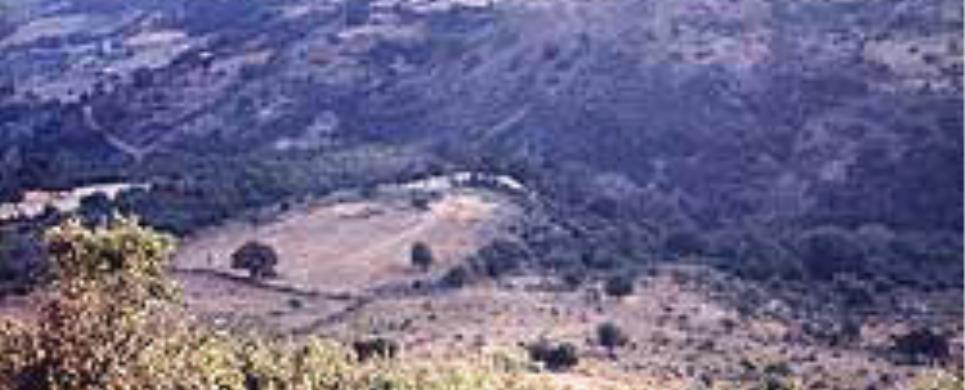Listed 13 sub titles with search on: Archaeological sites for wider area of: "ILIA Prefecture WEST GREECE" .
BASSAE (Ancient sanctuary) ILIA

The temple is situated on a slope of Mount Lykaeo and was designed
by Iktinos, the architect of the Parthenon, during the Peloponnesean War at the
end of the 5th century (410 B.C.) to thank god Apollo for his help and to induce
him to banish evil from the area, when great famine had plagued the area. Iktinos'
genius and his refusal to conform to the architectular norms made him combine
the three ancient architectural styles in the most harmonious way; the doric with
the outside pillars, the Ionian with the semipillars and the Corinthian with the
two pillars for the north entrance and the two for the south. On the famous zoeforos
of sculptor Alkamenous dear themes from mythology were reproduced, and it is placed
in the niche of the temple on the top part of the semipillars which supported
the top in contrast with the other temples.
Until 555 A.D. the temple maintained its glamour when an earthquake
and the spreading of Christianity led it to obscurity which was completed in the
Byzantine Years. It was discovered by the French traveller BOUCHET in 1765 A.D.
and it was immediately looted by foreign as well as Turkish smugglers of antiquities.
The English Gropus in cooperation with Veli pasha, governor, then, of Morias,
stripped the temple of all the archaeological remains in 1812. He sold those in
auctions to the rich of the West like the Ionian zoeforos which was bought by
the King of England, George the 4th.
This text is cited Jan 2003 from the Messenia Prefecture Tourism Promotion Commission URL below, which contains image.

AGIA TRIADA (Village) ILIA
Tel: +30 27230 22448
KAKOVATOS (Village) ZACHARO
Near a Mycaenean settlement at Kakovato three domed tombs have been found.



Travellers located the city of ancient Elis in the 19th century and indeed
prepared topographical plans. The first systematic excavations were conducted
by the Austrian Archaeological Institute between 1911 and 1914, under the direction
of Otto Walter. Since 1960 excavations have been continued intermittently by
the Archaeological Society at Athens. Rescue excavations carried out by the
VIIth Ephorate of Prehistoric and Classical Antiquities, between 1965 and 1970,
when the irrigation channel of the Peneius dam was being constructed, uncovered
part of the ancient city.
The following buildings were revealed or located and subsequently identified
on the basis of Pausanias' descriptions: Gymnasium, which has not been excavated
but seems to have had the same dimensions as that of Olympia (approx. 200m long);
Baths, to the west of the agora; Temenos of Achilles; Hellanodikaion; 'Southward'
Stoa; 'Corcyraian' Stoa, which was the south border of the agora; various small
sanctuaries; a square building with internal peristyle cort where the sixteen
Eleian women wove the peplos of Hera; a section of the peribolos (enclosure)
of the temenos of Aphrodite; another peribolos of the sanctuary, a small temple
and precincts, among them one of Hades; and finally the theatre to the north
of the agora.
The theatre was built in the 4th century BC and remodelled in Hellenistic and
Roman times. The stoneskin with the proscenium and the paraskenia are among the
oldest in ancient Greece. The audience did not sit in seats but on the hill slope,
just as they did in the stadium of Olympia. Six stone stairways gave access to
the cavea and divided it into seven cunei. An elaborate drainage network safeguarded
the theatre from the danger of flooding. The theatre ceased to function in late
Roman times, when the city in general went into decline, and a cemetary with clusters
of cist and tile-roofed graves was created here.
The Elis Archaeological Collection
Founded in 1981, the Collection includes finds brought to light
in the excavations in Elis. These date from the Early Helladic period to the Roman
Age. Vases, statues, sculptures, funerary stelai, teracotta adn stone architectural
members, figurines, bronze vessels, weapons, coins and other minor objects are
exhibited.
Of particular interest are the broze theatre 'tickets', inscribed with the designation
FA(ΛΕΙΩΝ), meaning 'of the Faleioi', i.e. Eleians, which were found in
large number and date from the late 4th century BC, as well as the teracotta face
masks and the female figurines, which are excellent examples of Eleian coroplastic
art.
Outstanding are the two sections of mosaic floors displayed in the atrium of the
Archaeological Collection. They come from a large villa of the 3rd century AD,
built to the southwest of the agora of Elis. The representations are in circular
arrangement: on one the relate to the Nine Muses and on the other to the Labours
of Herakles.
Xeni Arapoyanni, ed.
Translation by: Alexandra Doumas
Cited Sep 2002, from the Municipality of Amaliada information pamphlet

Receive our daily Newsletter with all the latest updates on the Greek Travel industry.
Subscribe now!